By Tiffny Rhodius
Elford Liverpool, the curator of the National Museum, is confident that a five-year plan which is being developed to boost its services will draw larger crowds and give the public a more rewarding experience on a visit to the museum.
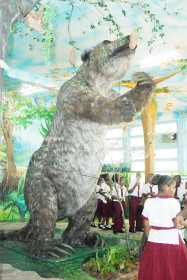
Liverpool has been the curator of the National Museum for over a year. A biologist who has been trained in museum management and taxidermy, he expects some aspects of the plan to come to fruition by the end of the year which will put the institution into the spotlight.
Plans
With attendance on the increase, Liverpool told Stabroek News last week that he is looking at more ways to draw attention to the museum and make it a must-see for local and overseas visitors. The five-year plan which will be submitted at June month end, seeks to promote the use of the museum and make the visiting experience more attractive. While some of the plans are extensive and ambitious, Liverpool promises visible changes in the look and the display of the building as early as the end of the year.
Currently the museum is working on displaying a new set of exhibits and redesigning and changing the layout of its social history section, with the aim of highlighting the historical development of the country. It also plans to open a museum shop which will sell souvenirs, memorabilia, T-shirts and miniature replicas of certain exhibits like the Mega-T Giant Sloth. Also, the exterior of the building will be given a facelift with a fresh coat of paint, signs will be erected and the grounds developed.
A cartography room is also to be created which the Culture Ministry had announced last month when The Netherlands had handed over to the National Archives digitised Dutch maps of Guyana. Liverpool said the cartographic map room will chart Guyana’s historical development and will show how the map developed. To keep things fresh and exciting, exhibits of the cartography room will be rotated to highlight various aspects of the collection. The room is expected to be completed sometime next year.
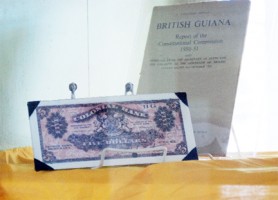
With all the big plans for the museum, Liverpool pointed out that staff too will need to be trained in areas such as customer service, tour- guiding and in taxidermy so that it can function more efficiently. Promotional activities are key aspects of the five-year plan.
Challenges
However, Liverpool admits that these big plans for the museum face two major problems: financing and staffing. While the Ministry of Culture, Youth and Sport has allocated over $12M from the budget to the museum, he said this sum “cannot sustain all of the projects of the museum” although the plan is expected to receive its own budget. In the meantime, Liverpool said outside assistance is being sought in order to realise most aspects of the plan. “The museum can’t do it alone, the private sector needs to come on board,” he said, pointing out that private sector partnership will be particularly needed to obtain stock for the museum shop, to open a food court for visitors and to develop the museum’s lawns to make it more attractive.
Liverpool did tell this newspaper that it had received assistance from some private sector businesses to fulfil its mandate, referring to the Mega-T exhibit which was a government, private sector and overseas collaboration.
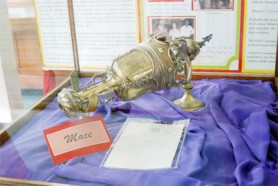
As regard staffing, he said there is need for more staff in the research and education unit and attendants. He said the institution also needs persons who are trained in marketing as it creates brochures and other documentation for exhibitions. The taxidermist said the institute is challenged by “the lack of access to materials and museum resources that are required on a daily basis.”
Exhibits and Mega-T visits
Despite the prevailing impression that the museum has few artefacts, one staffer said it has many items in storage. According to Liverpool it has acquired a number of never-before-seen exhibits over the past two years but they are awaiting chemicals to treat them before putting them on display. “People can come and look forward to new exhibits in Natural History and new design and layout in Social History focusing on Guyana and its development,” he said.
When this newspaper pointed out that some of the exhibits on display had been there a long time, Liverpool agreed that this was true but added that though there are plans for the rotation of exhibits, the timeline for the duration of exhibits has not yet been worked out.
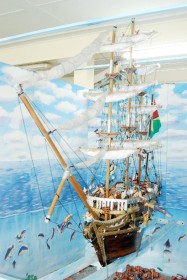
The bottom flat of the museum is frequently rearranged to host exhibits such as the Independence Exhibition which recently ended. As for the acquisition of artefacts, Liverpool said the museum does not purchase artefacts but accepts donations. It also acquires items on field trips, takes samples and accepts road kill which goes on display in the Natural History section.
Meanwhile, Liverpool said that visits to the museum have increased significantly. “An analysis comparing 2008 to 2009 showed a 7,000 increase in visits to the museum by both adults and children,” he said. Further, for the past five months the average number of people visiting the museum has doubled and during May it recorded 5,000 visitors with 400 persons visiting inone day alone.
While he attributes the influx to the many exhibitions held almost monthly at the museum, the Mashramani Exhibition drew twice as many persons than it did last year but the main attraction is the Mega-T sloth exhibition which opened in April. Ten years ago, the fossils of the giant sloth was found in the interior and there were plans to display the bones at the Walther Roth Anthropology Museum. These plans did not materialise and under the direction of Culture Minister Dr Frank Anthony the Mega-T exhibition gained shape. Germany said it had actual replicas of the Mega-T and talks began between the two nations with some private sponsorship.
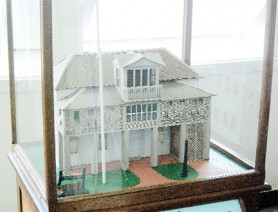
The Mega-T has since drawn much attention, leaving the public awestruck. When Stabroek News visited the museum it noticed two things: persons kept asking if was real and children kept calling the sloth a bear. According to Liverpool work is being done to create brochures which would provide information and facts on the creature. The brochures will be given to students free of charge but will attract a small fee for other visitors in order to cover printing costs.




